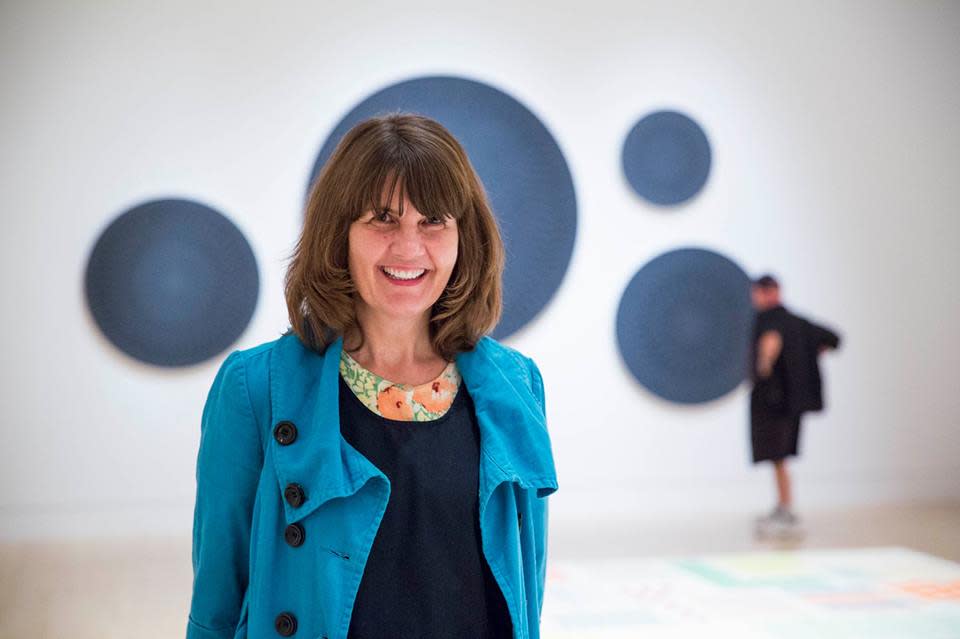What Kind of Art Is Portland Producing?

Michelle Grabner
The curator of the 2016 Portland Biennial is a painter, conceptual artist, faculty member of the School of Art Institute of Chicago, and was a co-curator of the 2014 Whitney Biennial. Michelle Grabner gives her first major public lecture in Portland since her July appointment on Thursday at 6.30 pm at PNCA in an event free and open to the public. We caught up with her in advance of the lecture to find out what she's looking for as she wades through hundreds of applications and visits studios all over the state, and what artists from all over Oregon have in common.
How would you define your approach as a curator?
I would probably define my approach to curating as from an artist’s perspective—being an artist myself—where being in the studio is very important, talking to artists is very important. I’m not at all interested in illustrating my own ideas, or my own thinking, but in taking the temperature of what’s going on. In the case of the Portland Biennial, it's about taking the temperature of what’s going on in terms of art ideas, and the relationship with making in the state.
What interested you in this role as the curator of the Portland Biennial?
From the center, you’re getting a nice diversity of ideas being played through, but the intimacy, the closeness, the tighter relationship to context—that’s something that a regional biennial can offer.
How do you see the role or purpose of the Biennial as a driver for art?
Fundamentally, artists rally behind the Portland Biennial. Unlike the Whitney Biennial, where you have curators going out, talking to other artists—and I’m doing that to a certain degree—there was also an application process, where pretty extraordinary artists threw their hats in the ring. That doesn’t happen in all sectors of the art world. I’m looking at extraordinary applications from emerging and mature artists.
So it’s clear Portland’s artists really rally around it and see the Biennial as something that—if you’re in the studio, if you’re an artist— you want to participate in. It seems profoundly meaningful. Seeing the breadth and diversity of artists who really find it important, who want to be represented in something that represents the state, that’s pretty great.
Is there something culturally distinct about Portland or Oregon that brings this about?
I think it’s not at all less sophisticated, less complex in terms of how artists are engaged in concepts and ideas, in making, but I think there is an understanding that there’s something about the landscape, the vastness of where the Northwest is located—it is very far away. The West coast does seem to be almost at the edge of the world, and that distance, that real geological difference, does make for a different contouring of how artists think about community. And again, it’s not as if it’s a backwater or thinking is less rigorous – I have to say actually, and maybe to my surprise, that the studios I’ve been into are really sophisticated.
What did you expect to find in your work curating the Biennial? What do you think you were looking for?
I think I understood that we’d get what we got: a generalized spread of degrees of rigor, sophistication, engagement of ideas—a good share of Sunday painters, but not as many Sunday painters as I thought there would be. Or maybe it’s that even the Sunday painters are dedicated here.
What are you looking for in terms of the selection process for the Biennial?
I think it’s about getting excited. When having a conversation with an artist in their studio, if they’re challenging me, if they’re asking me to think about art making and an idea in a different way than I’ve thought about it before, that is something that I make important note of. I don’t have any expectations going in—I have a lot of respect for artists. All artists work hard, so it’s about whether, once I’m in the studio, something will become unlocked.
Even if I don’t really know what I’m looking at in the application process, I try to be as generous as possible and go into as many studios as possible. Once I’m there, if I’m being challenged, in thinking about art making, and what art making can be—I’m not talking about just looking for the contemporary avant guard, but also something that expands something more traditional because of the craft—that is something I’ll take a look at as well.
Do you think there is something distinctive about the artistic output from Oregon? How would you describe it?
Landscape and environment is really at a the core of a lot of thinking here, and that’s interesting and unique. I haven't seen that even in the Midwest. So that is one thing that is I think quite obvious to those who live in Oregon but came as a surprise that it’s so prevalent.
The other thing I would say is a sense of humor. I came across a lot of work that has a really interesting witticism to it, a kind of self-knowingness—a humor, that’s maybe slightly self deprecating.
Then there’s a high degree of craft. Whether it’s painting, sculpture or video making, pretty impressive making skills are at hand. That is fundamental, regardless of whether it’s taking on landscape or taking on a comedic relationship to the every day. So I think those three things have really come to the fore.
Michelle Grabner gives her first major public lecture since becoming the curator of the 2016 Portland Biennial on Thursday, Nov 19, at the Arlene and Harold Schnitzer Center for Art Design Mediatheque at PNCA's 511 building. There'll be a livestream here for those who can't attend in person.
